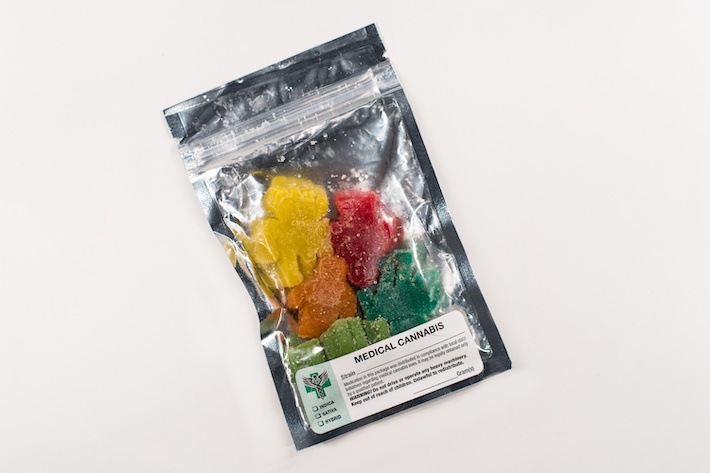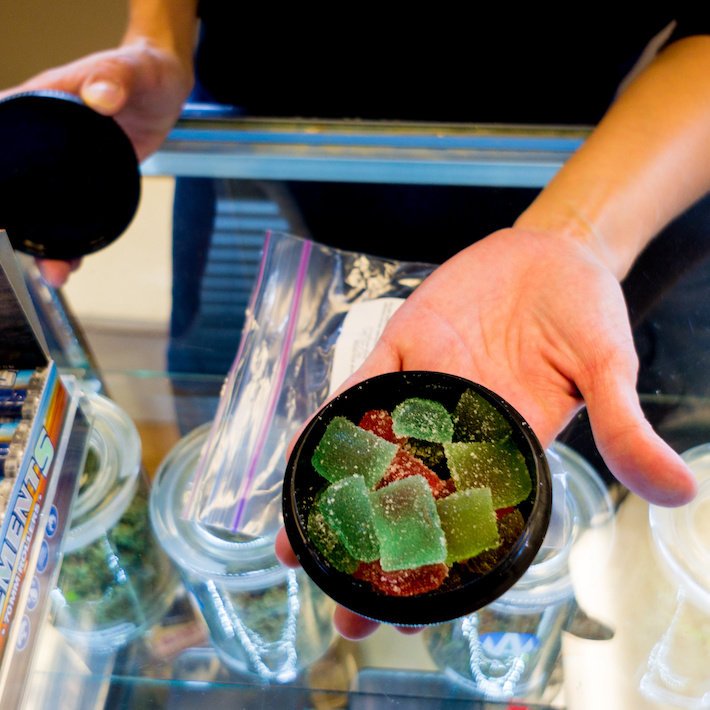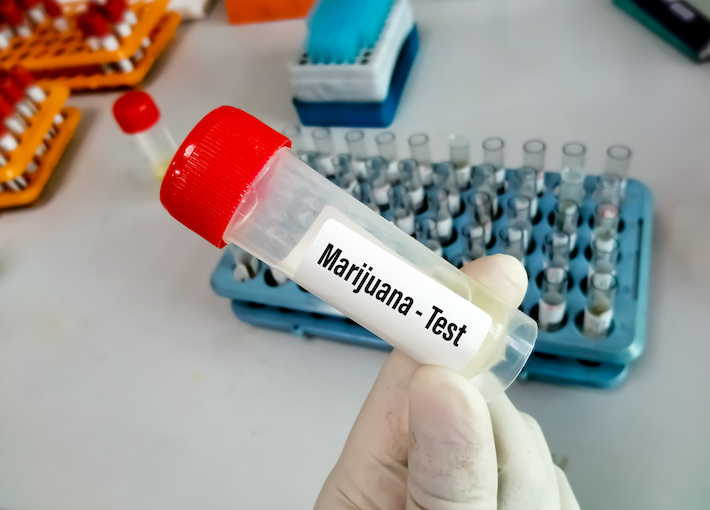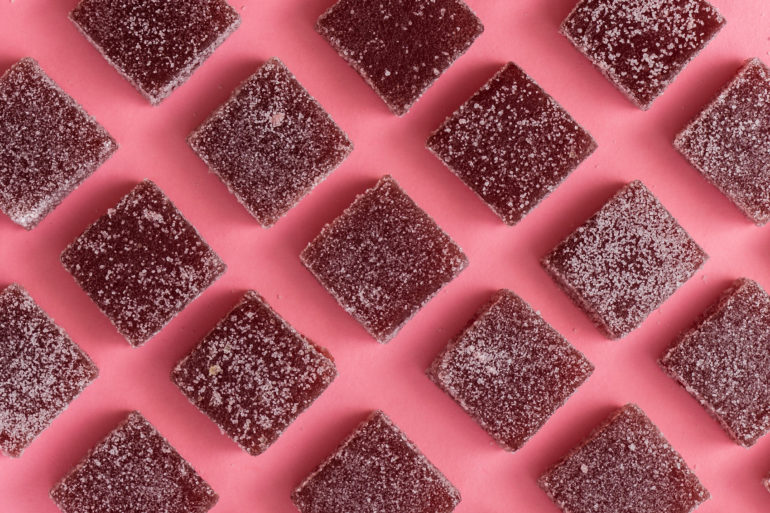Edibles are a great way to get high, especially if you’re new to weed, but there are a few things to think about before taking the dose. Firstly, it’s easy to go too far with edibles, so you need to be careful about your actual dosage. However, if you get tested for THC at work, it’s important to know how long the THC from the edibles will be detectable in your body.
The good news is that unless you’re a regular user, edibles generally won’t stay in your system for too long.
Key Takeaways
- Edibles stay in your system for shorter periods if you don’t use cannabis regularly, or longer periods if you do.
- For urine tests, if you don’t use regularly you’ll probably be clear in 4 to 5 days. If you use regularly it can be up to 21 days.
- For blood tests, THC will be detectable for 1 to 2 days, although this can increase for regular users.
- Saliva tests aren’t hugely effective for edibles, but it’s better to play it safe and assume a detection time of between 1 and 3 days.
- Hair keeps THC metabolites for up to 90 days, so if you have a hair test any time in the near future you will probably test positive.
How Long Do Edibles Stay in Your System?

If you use cannabis less than 3 times a week, edibles stay in your urine for around 3 days after your last use. If you use cannabis daily, it could be present for between two weeks and a month.
The method you used to consume the THC isn’t usually considered relevant to this point, because no matter how it ends up in your body, it’s basically removed in the same way. So whether you eat an edible or smoke a joint, the result is usually the same. The differences are usually just related to dosage.
We spoke to Dale Gieringer, PhD from California NORML, who has published research on drug urinalysis, and he said that while there isn’t enough evidence to say how method of consumption affects THC’s detection time, “Anecdotal reports indicate that edibles stay in the body longer. [It] probably depends on the type of test used.”
THC and metabolites are stored in your fat cells, which means that it stays in your body for longer than most drugs do. However, the detection windows depend on what exactly is being tested (e.g. urine, blood, hair or saliva) and how much you use in a more general sense.
Edibles Stay in Your Pee From 3 Days to Over 21 Days
Regular users will likely have THC metabolites in their urine for a week or two after their last use.
Dr. Abraham Benavides, medical cannabis coach and consultant, explained to us that:
“Most drug tests are federally-standardized urine drug screen (UDS) panels looking for the metabolite of THC, called THC-COOH. Our body starts to turn THC into THC-COOH as soon as it hits our liver. THC is rapidly metabolized, but the metabolite THC-COOH itself can take a very long time to finally leave the system because our body does not perceive it as harmful. It has the longest testing window of all the drugs on the panel.”
Adding, “This is why drug screens are very flawed for distinguishing recent or any past cannabis use from people with actual substance use disorders.”
In practice, the data suggests:
- For occasional users (up to three times a week), or first-timers, urine tests will detect your cannabis use for up to 3 days.
- If you use four times a week but not daily, it will be detectable for between 5 days and a week after eating the edible.
- For daily users, the THC metabolite will be in your urine for between 10 and 15 days.
- If you partake multiple times a day, it could be detectable for 21 days or possibly longer.
Think of it like this: the more you use cannabis, the more of it builds up in your fat cells. It reduces at a pretty steady rate, but if you add to it quicker than it can reduce, the amount stored will grow and grow. Whenever you do actually stop, there is a bigger “backlog” for your body to work through and so it remains detectable for much longer.
One study conducted at a Navy rehab center found that the average time it took regular users to test negative for marijuana was 27 days after last smoking, with a maximum of 46 days in the group. However, this study used a 20 ng/ml cutoff, whereas most workplace tests use 50 ng/ml (which is the federal cutoff value for initial tests). Additionally, there was some indication that some participants actually smoked again after the study started, with an unexplained second peak in urine levels visible in the data.
Finally, it’s worth noting that there is some evidence that consuming edibles may increase these times. One National Institute on Drug Abuse study showed that the metabolite of THC was detectable for almost six days after the ingestion of two brownies. This was the most extreme case, though, for more typical results it was around 3 to 5 days.
Edibles Stay in Your Blood for Around 1 to 2 Days
Edibles will only remain in your blood for a couple of days unless you’re a regular user. If you just have an edible once, blood tests will probably only show it for a day.
Blood tests are the most direct approach to test for THC, and as a result they have a much narrower detection window than urine tests. For this reason, they are generally used in cases where people are looking for recent use of cannabis.
Generally, THC will be detectable in blood for 1 to 2 days after use. However – as with urine tests – regular heavy use will increase the amount of time it’s detectable. In one extreme case, it was detectable for up to 25 days.
Note that while many sources say that THC is only detectable in blood for a few hours, this is based on detection times for THC itself (which are much lower). Blood tests for THC can also look for its metabolites, and these are detectable in blood for longer.
Edibles Stay in Your Saliva From 1 to 3 Days

If you’re being tested in line with federal recommendations, edibles will only be detectable in your saliva for 1 – 3 days. However, if you fail the screening, the confirmatory test can detect edibles for two weeks or possibly longer in regular users.
However, the best evidence available for edibles suggests that the situation is a bit more complicated in this case. For example, one study tested less-than-daily users after a single dose of between 5 and 15 mg of THC, and found that their results weren’t very different from people who only took a placebo. For higher doses (20 to 25 mg of THC), the values reached a peak around 1 to 2 hours after the first dose, and then decreased after that.
One National Institute on Drug Abuse study tested 28 daily cannabis users’ saliva during a period of monitored abstinence. When using the federally-recommended cutoff values, past cannabis use was detected for less than 48 hours in the group. However, after the screening (for THC itself), positive samples are tested for the metabolite (THC-COOH), which in the study was still found after a median of 13 days.
Dr. Benavides commented to us that, “Edibles will produce less active THC in your mouth because the THC is a distillate dissolved into the product which is immediately ingested. Unless the edible is sitting in your mouth for several minutes like a tincture does, little THC is absorbed through the mouth or left behind except for the remaining food particles that can be washed out.”
He drew a comparison with smoking, “With smoking, active THC along with cannabis tar and resin are being deposited and sequestered throughout the mouth and teeth upon inhalation. This means that at least immediately (1-2 hours after smoking) there is more active THC than with edibles”
Finally adding, “However, if the sample is still flagged you’re more likely to find a greater amount of THC-COOH after edibles than smoking.”
In short, it’s best to err on the side of caution – and take 1 to 3 days as the detection time regardless – but realistically, saliva THC is not the best measure to pick up use of edibles.
Edibles Stay in Your Hair for Up to 90 Days
Finally, edibles will remain detectable in your hair for around three months. However, it’s possible it wouldn’t be detected at all in a “screen” for THC itself.
It’s worth noting that authorities generally don’t use hair testing, because urine is easy to test and covers a much more recent time period. Additionally, hair testing isn’t the most effective approach to use in terms of accuracy – in one test, almost half of people who smoked weed under lab conditions had their hair test negative. The test used in this study had two parts: a screening test for THC (which likely wouldn’t flag edibles use) and a confirmatory test (which likely would).
Despite some issues, for things like checking abstinence from drugs in clinical trials and similar circumstances, hair tests are fairly common. It’s also becoming more common in general despite its limitations.
The issue for people using cannabis is that the metabolite will remain detectable in your hair for some time, even if you’re an occasional user. In fact this is part of the reason it’s used in some cases despite urine testing being relatively more specific and reliable (though still imperfect).
If You Fail a Test, You Have a Right to Challenge the Result

If the worst happens and you fail a drug test, all is not necessarily lost: you can challenge the result.
Joe Reilly, an expert in workplace drug testing, pointed out to us:
“Both prospective employees and [existing] employees have a right to challenge their positive drug test result. The challenge process is coordinated by the Medical Review Officer who reviews and verifies the final result. The donor can request his or her specimen to be sent to another certified laboratory for independent retesting, this hardly ever leads to a different result.”
In other words, yes you can challenge the result. But unfortunately no, it probably won’t change anything.
RELATED: What Is the Best Defense for a Positive Drug Test?
Limitations of the Evidence and Gaps in Knowledge
Although there have been many studies on how long THC will stay in your system, the methodologies of the studies sometimes leave a lot of uncertainties. As mentioned above, in many cases it was hard for researchers to confirm that the people involved had been abstinent the entire time. Additionally, many claims found online (e.g. THC remaining in your urine for longer than a month) tend to depend on a single extreme example from a larger dataset.
In short, while the information above is likely accurate in a broad sense, the specifics vary a lot with different individuals and some of the evidence is likely exaggerating how long THC stays in your system.
Additionally, there is very limited evidence on how using edibles affects detection times, compared to smoking. Dale Gieringer commented to us that there is “insufficient evidence” to make a call on this at this stage.
Conclusion
The answer to “how long do edibles stay in your system?” is “longer than you would hope,” but unless you’re a regular user, you’ll probably be clear in 4 to 5 days. If you use cannabis daily, there isn’t much you can do to get it out of your system, and if you have a urine test you’d likely need a month before you’re clear. With saliva and blood tests, you’ll be clear after a few days, but if it’s a hair test, it will be detectable for months.
And as always, if you do partake, remember to start with a low dosage and go slow.
Related Articles
- How to Pass a Marijuana Drug Test?
- Can You Dispute a Positive Drug Test?
- How Long Does Cannabis Stay in Your System? (Urine, Saliva, Blood)
- Can You Fail a Drug Test From Second-hand Smoke?
- Can You Detox Weed Out of Your System?
- Does Delta-8 THC Show Up on a Drug Test?
- Does CBD Show Up on Drug Tests?
References (16)
- Andrenyak, D. M., Moody, D. E., Slawson, M. H., O’Leary, D. S., & Haney, M. (2017). Determination of ∆-9-tetrahydrocannabinol (THC), 11-hydroxy-THC, 11-nor-9-CARBOXY-THC and cannabidiol in human plasma using gas chromatography–tandem mass spectrometry. Journal of Analytical Toxicology. https://doi.org/10.1093/jat/bkw136
- Cary, P.L. (2005) “ Marijuana Detection Window: Determining the Length of Time Cannabinoids Will Remain Dectectable in Urine Following Smoking: A Critical Review of Relevant Research and Cannabinoid Detection Guidance for Drug Courts,” Drug Court Review, 5(1). Available at: https://www.ojp.gov/ncjrs/virtual-library/abstracts/marijuana-detection-window-determining-length-time-cannabinoid
- Cone, E.J. et al. (1988) “Marijuana-laced brownies: Behavioral effects, physiologic effects, and urinalysis in humans following ingestion,” Journal of Analytical Toxicology, 12(4), pp. 169–175. Available at: https://doi.org/10.1093/jat/12.4.169
- Ellis, G.M. et al. (1985) “Excretion patterns of cannabinoid metabolites after last use in a group of chronic users,” Clinical Pharmacology and Therapeutics, 38(5), pp. 572–578. Available at: https://doi.org/10.1038/clpt.1985.226
- Gryczynski, J. et al. (2014) “Hair drug testing results and self-reported drug use among primary care patients with moderate-risk illicit drug use,” Drug and Alcohol Dependence, 141, pp. 44–50. Available at: https://doi.org/10.1016/j.drugalcdep.2014.05.001
- Gunasekaran, N. et al. (2009) “Reintoxication: The release of fat-stored Δ9-tetrahydrocannabinol (THC) into blood is enhanced by food deprivation or ACTH exposure,” British Journal of Pharmacology, 158(5), pp. 1330–1337. Available at: https://doi.org/10.1111/j.1476-5381.2009.00399.x
- Kulig, K. (2016). Interpretation of workplace tests for cannabinoids. Journal of Medical Toxicology, 13(1), 106–110. https://doi.org/10.1007/s13181-016-0587-z
- Lee, D., Milman, G., Barnes, A. J., Goodwin, R. S., Hirvonen, J., & Huestis, M. A. (2011). Oral fluid cannabinoids in chronic, daily cannabis smokers during sustained, monitored abstinence. Clinical Chemistry, 57(8), 1127–1136. https://doi.org/10.1373/clinchem.2011.164822
- Lee, D. and Huestis, M.A. (2014) “Current knowledge on cannabinoids in oral fluid,” Drug Testing and Analysis, 6(1-2), pp. 88–111. Available at: https://doi.org/10.1002/dta.1514
- Mandatory Guidelines for Federal Workplace Drug Testing Programs, Vol. 87, No. 67, Fed. Reg., 20522, April 7, 2022. Available at: https://www.federalregister.gov/documents/2022/04/07/2022-06884/mandatory-guidelines-for-federal-workplace-drug-testing-programs
- Moeller, K.E. et al. (2017) “Clinical interpretation of urine drug tests,” Mayo Clinic Proceedings, 92(5), pp. 774–796. Available at: https://doi.org/10.1016/j.mayocp.2016.12.007
- Newmeyer, M.N. et al. (2017) “Cannabis edibles: Blood and oral fluid cannabinoid pharmacokinetics and evaluation of oral fluid screening devices for predicting Δ9-tetrahydrocannabinol in blood and oral fluid following cannabis Brownie Administration,” Clinical Chemistry, 63(3), pp. 647–662. Available at: https://doi.org/10.1373/clinchem.2016.265371
- Niedbala, R.S. et al. (2001) “Detection of marijuana use by oral fluid and urine analysis following single-dose administration of smoked and oral marijuana,” Journal of Analytical Toxicology, 25(5), pp. 289–303. Available at: https://doi.org/10.1093/jat/25.5.289
- Reiter, A. et al. (2001) “Time of drug elimination in Chronic Drug Abusers,” Forensic Science International, 119(2), pp. 248–253. Available at: https://doi.org/10.1016/s0379-0738(00)00437-0
- Rohrich, J., Schimmel, I., Zorntlein, S., Becker, J., Drobnik, S., Kaufmann, T., Kuntz, V., & Urban, R. (2010). Concentrations of 9-tetrahydrocannabinol and 11-nor-9-carboxytetrahydrocannabinol in blood and urine after passive exposure to cannabis smoke in a coffee shop. Journal of Analytical Toxicology, 34(4), 196–203. https://doi.org/10.1093/jat/34.4.196
- Taylor, M. et al. (2016) “Comparison of cannabinoids in hair with self-reported cannabis consumption in heavy, light and non-cannabis users,” Drug and Alcohol Review, 36(2), pp. 220–226. Available at: https://doi.org/10.1111/dar.12412 Verstraete, A.G. (2004) “Detection times of drugs of abuse in blood, urine, and oral fluid,” Therapeutic Drug Monitoring, 26(2), pp. 200–205. Available at: https://doi.org/10.1097/00007691-200404000-00020

